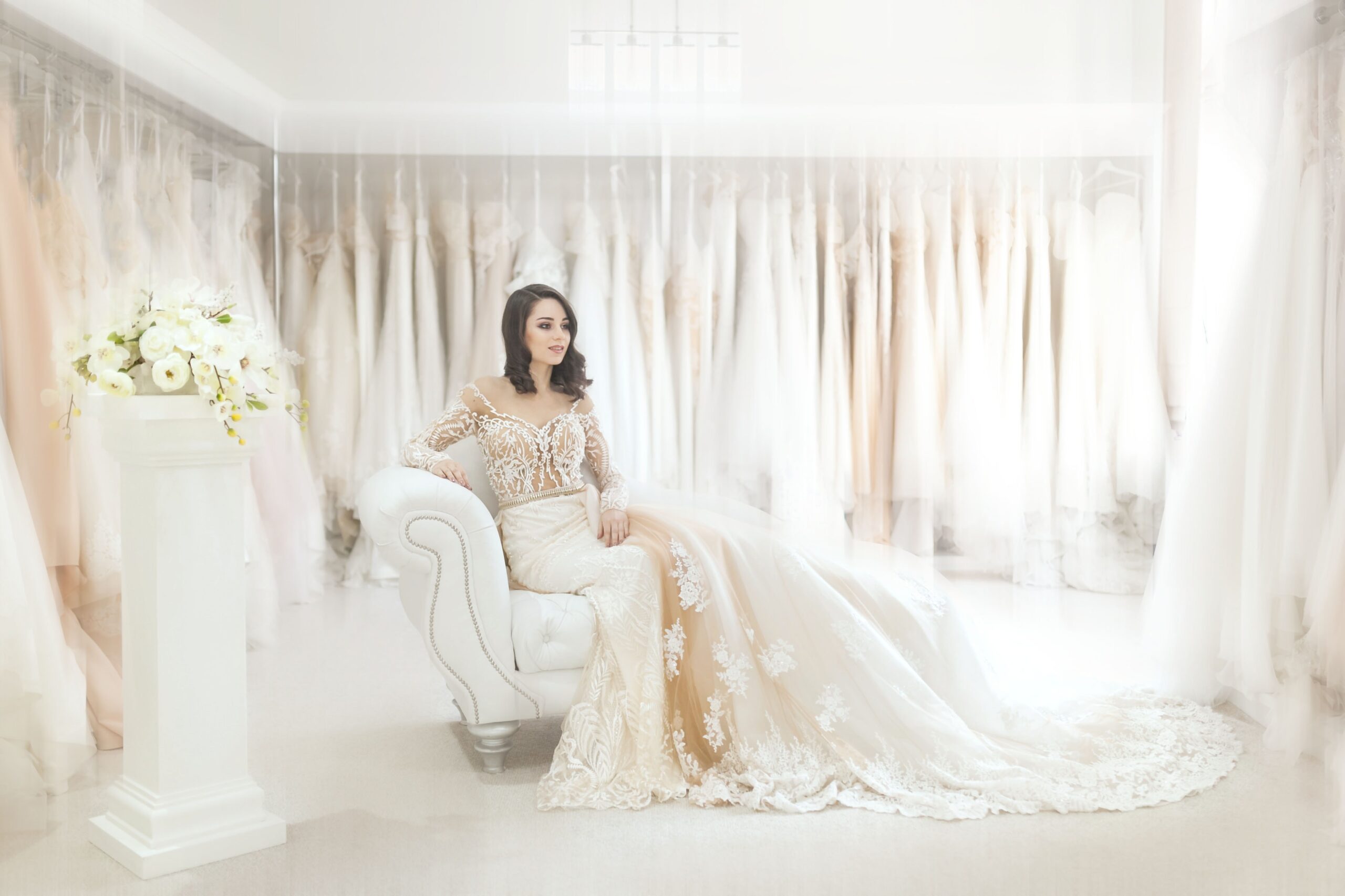Wedding dress trains transform bridal gowns into royal-level appearance, making you stand out both at the ceremony and at the wedding reception. This extra length of fabric, which extends from the back of the gown and trails behind you with every step you take may be part of a skirt, an overlay that connects to the waist, or a detachable piece.
Because there are different types of wedding dress trains, think about the kind of train you’d like to have depending on the type of wedding you wish to do. In this guide, we look at the bridal gown train styles and explain the factors that can help you determine what type of train is right for you.
Let’s get started.
5 Types of Wedding Dress Trains Explained
There are five types of wedding dress trains. And they’re as follows:
1. Chapel
A chapel train is the most common option among many brides because it’s easy to manage. Approximately 12 to 18 inches long, the chapel wedding dress train adds just enough extension to an A-line gown.
The chapel train measures from the waistline and extends four feet from that point, not to mention that it falls at most two feet from the bottom of the dress’ skirt. One of the best things about this type of chapel bridal gown train is that it’s perfect for any venue.
2. Cathedral
Cathedral trains are no less than 22 inches long. The longest ones can extend up to seven feet long and, as the name suggests, it’s an ideal choice for a cathedral venue where the aisle is not only long but also smooth – although it will work perfectly for any indoor setting.
Fully formal in design, and good enough to add some drama to A-line dresses and ball gowns, these trains are the best for black-tie weddings. The train can look its best if splayed out before the big day begins. So, talk to your wedding planner to help you with this.
You can also opt for the semi-cathedral train, which is an option that falls between the cathedral and chapel in length. It’s an ideal choice if you don’t find the length of the chapel decent enough but don’t want to feel somewhat intimidated by the cathedral length.
3. Royal or Monarch
Monarch is the longest type of wedding dress train. Because it extends a yard or more on the floor, the bride will need the help of a flower girl to move it around.
While a monarch train is accessible to anyone, it begs for the proper location because not every setting can accommodate a gown of this length. Outdoor locations with grass or soil are unsuitable for royal trains, as they will accumulate dirt and sticks.
Additionally, the more clothing there is, the heavier it will be. If you choose a royal train, ensure that your maid of honor and bridesmaids are prepared to carry it around and that you have a solid bustle on hand to secure it when it’s time to dance.
4. Sweep
Sometimes referred to as a brush train, a sweep train is about six inches long, and it can extend up to a foot long behind the bride. The sweep train adds a classic touch to the skirt of a bridal gown. It’s a perfect option for an outside wedding, and, because the drama lies in the silhouette, this train is perfect for brides who would like to look stunning in mermaid or trumpet dresses.
5. Court Train
A court train extends slightly beyond the point at which the dress meets the floor. And, like the chapel train, we measure its approximate length from the waist. Since it extends from the waist, the court train is a more formal option just like the cathedral, and it fits with a wider variety of styles, from A-line to sheath to mermaid.
Is Godet a type of wedding dress train?
A godet isn’t a type of wedding dress train. It’s a style created with a triangular piece of fabric and inserted into the train of a bridal gown to add some length and drama to the dress.
The purpose of the godet is to make the train flare out in fashion so that the pretty lace pattern is easily visible.
You can have one godet fixed in the center back of the wedding dress. Or you can choose to have multiple panels, particularly if you want to add volume to the skirt by creating folds.
Are there any wedding dress train alternatives to consider?
If you need an alternative to a wedding dress train, get a vail or a detachable skirt.
A Veil
A veil will add your desired level of drama to a wedding dress style that doesn’t include a train. Veils come in an assortment of lengths, so it should be possible to achieve the length of the train.
When it comes to using a veil as an alternative to a wedding dress train, choose the right length for the dress. In other words, a chapel-length bridal gown should have a chapel-length veil. You’ll have to try on many veils to find something that fits your dress and overall style.
Detachable Skirt
Detachable skirts are available in a variety of shapes and they can be translucent or opaque. You can use it to transform a fit-and-flare gown into a ball gown or to add a train to a floor-length silhouette.
The skirt can act as a train during the wedding ceremony and photography session. But you might want to consider detaching it from the gown for a stress-free reception. If you don’t want the inconvenience of subsequently bustling your gown, a detachable skirt might be your best bet.
Frequently asked questions
What is a train on a wedding dress?
What Is a Train? A train is an extra length of fabric that extends from the back of your wedding dress and trails behind you as you walk. It may be part of your skirt, could be a detachable piece or overlay that connects to your waist, or could be a Watteau style, which attaches at the shoulders like a cape.
How do you walk in a wedding dress with a train?
If your dress is super-full or designed with a train, try not to walk or step backward (again, you’ll risk ripping the fabric). Instead, reach behind you and delicately lift the back of your skirt with your hand, or enlist the help of an attendant.
Should the veil be longer than the train?
Most will say that a veil should not just match the length of your train but extend at least an additional 5″ at least. We suggest wearing it with at the very minimum a gown that meets the floor for an extra dramatic effect.
What is the origin of a wedding dress train?
Trains have been around since medieval times. At weddings, they were used to wow the guests, and to give an outward sign of wealth. As a train is an extra piece of material that serves no practical function, it was seen as elaborate. The longer the train, the wealthier the family must be.
What is a Watteau train?
The Watteau Train is the perfect look for brides who want a casual dress with a dash of formal flair. Unlike the traditional cathedral train, a Watteau train attaches to the shoulders or upper back of the bodice, giving it a draping cape effect as it lightly trails the bride.
Who holds the bride’s train?
Traditionally, page boys (attendants) carry the bride’s train, especially if the bride is wearing a dress with a long train. Because of the difficulty of managing a train, page boys are generally no younger than age seven, with older boys being preferred for more complicated duties.
Conclusion
There are no hard and fast rules when it comes to choosing the type of wedding dress train. However, you need to make sure you look your very best. So it helps to do a lap or two to see how the train drapes behind you. By doing so, you’ll be able to identify the kind of train you’d be more comfortable walking with.

